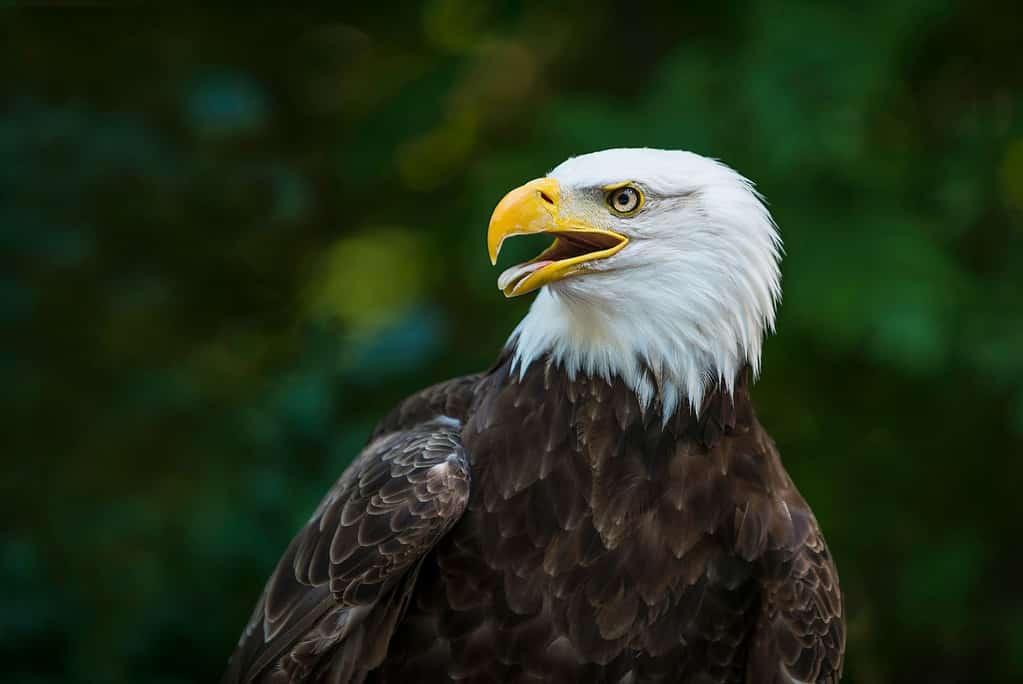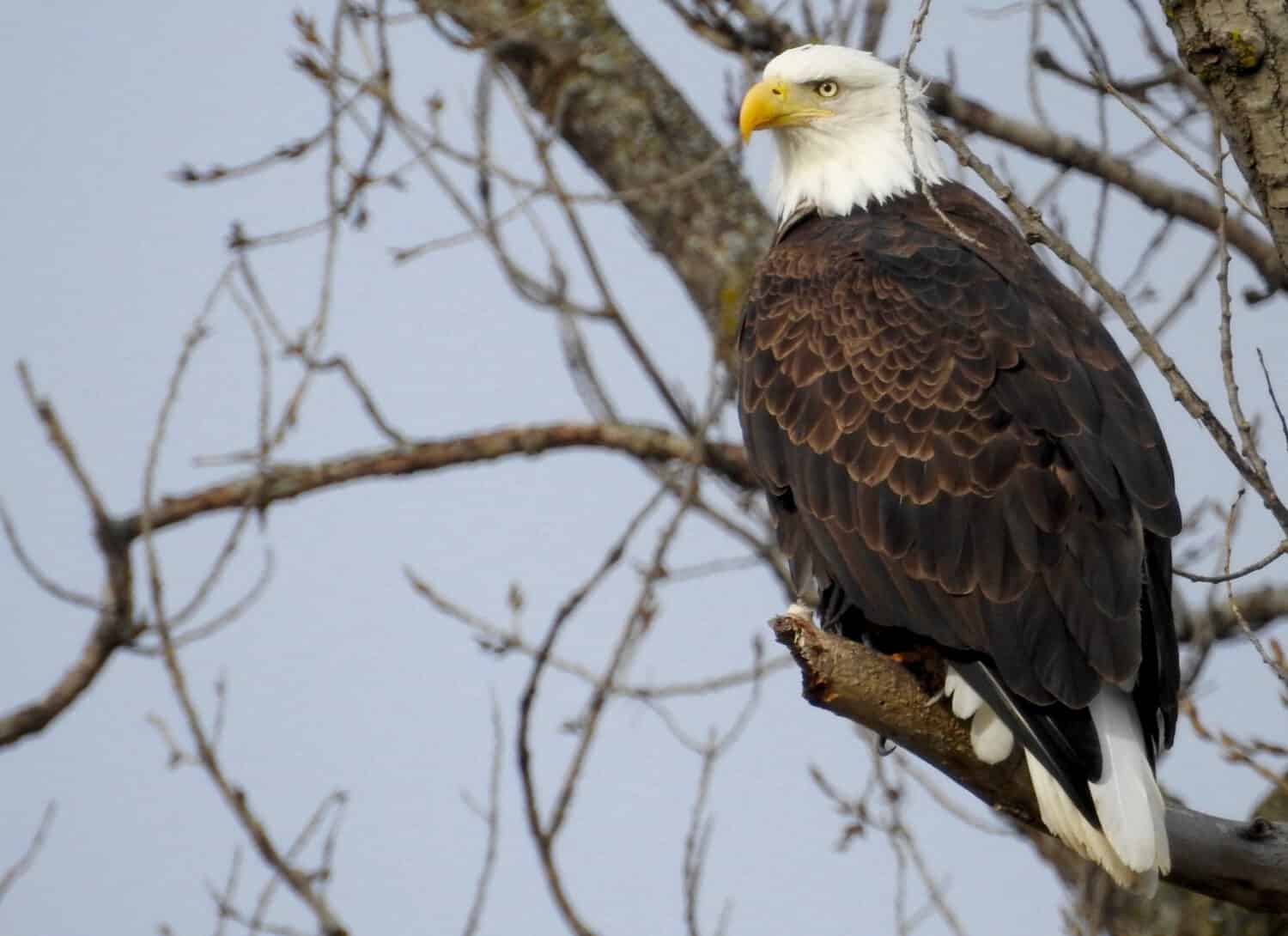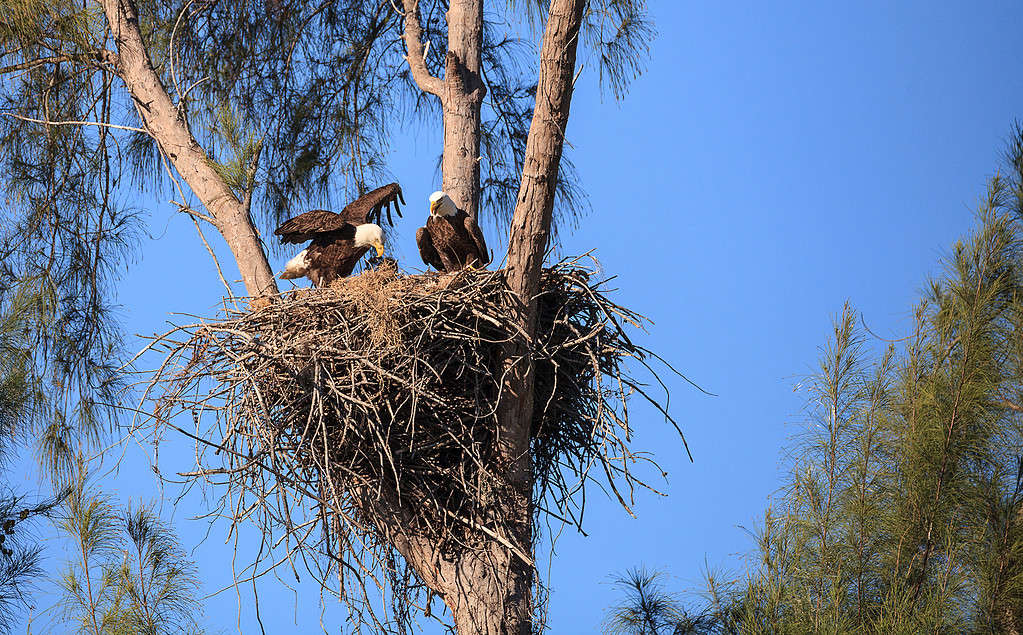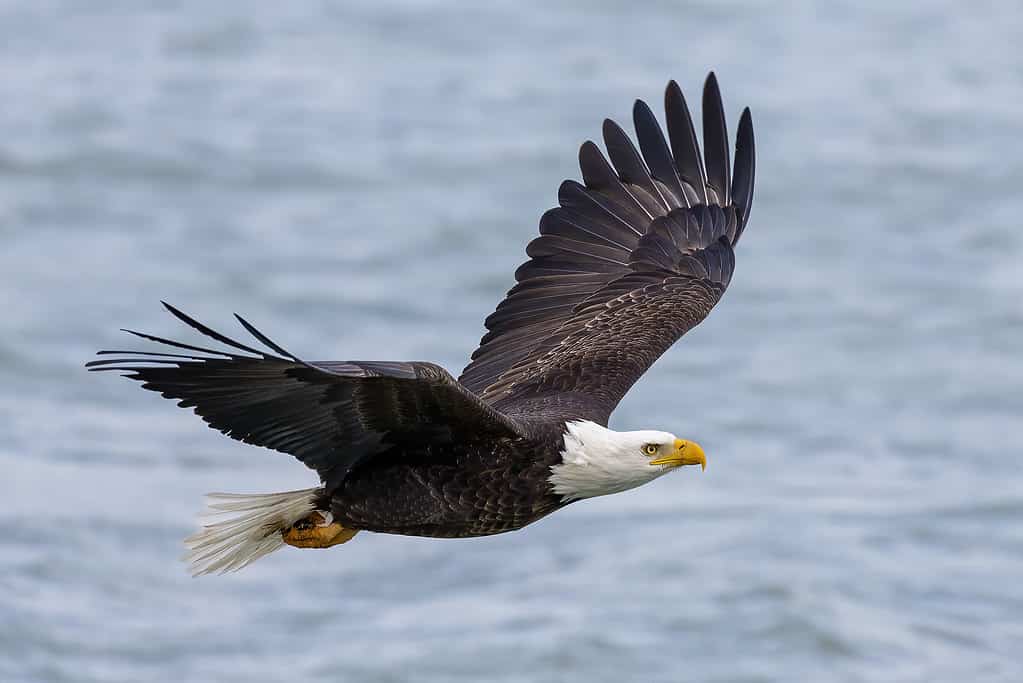The bald eagle (Haliaeetus leucocephalus) was designated as the national bird of the United States in 1782 when it appeared with outstretched wings on the Great Seal of the United States. This designation did not save the bird from experiencing turbulent and difficult times, though. Far from it! The U.S. national bird eventually became endangered and began flirting with extinction. However, this American icon has mounted one of the greatest comeback stories in U.S. conservation history. Let’s explore the history of bald eagle population numbers in the United States as a whole, as well as Florida and New York State specifically.

The bald eagle has a difficult history, but the U.S. population is coming back in a big way.
Bald Eagle Historic Population Trends
President Bill Clinton noted in remarks given in 1999, “In 1782, when the Continental Congress selected the bald eagle for the Great Seal of the United States, as many as half a million eagles soared the skies of North America.”
This number noted by President Clinton included roughly 100,000 bald eagles in the land that would become the continental United States. That robust population would be decimated in the years that followed, though.
Many farmers and fishermen viewed the bald eagle as a threat rather than a symbol of national pride. In fact, the Alaska Territorial Legislature went so far as to put a bounty on bald eagles in 1917. This was largely at the behest of the salmon fishing industry and coastal fox farmers. The per-eagle bounty started at fifty cents and would grow to two dollars by 1953, the last year the bounty was in place.
But the threats to bald eagles were not confined to Alaska. These raptors also faced a grave situation in the continental U.S. Loss of habitat and prey had a damaging effect on the eagles, but nothing would compare to the devastating impact of dichloro-diphenyl-trichloroethane (DDT).

This bald eagle has a sockeye salmon in its grasp.
©iStock.com/Schaef1
DDT
DDT was the first modern synthetic insecticide. Developed in the 1940s, it quickly gained popularity in agriculture throughout the world. Chemical runoff from fields treated with DDT flowed into U.S. waterways. Fish then absorbed it, the bald eagle’s primary prey.
The chemical caused a precipitous drop in bald eagle reproduction. Due to the pesticide build-up in their bodies, bald eagles began laying thin-shelled eggs that were too fragile to survive incubation. Many eagles stopped laying eggs altogether.
On top of this, farmers often shot bald eagles. They were seen as threats to poultry and small livestock. Hunters also viewed the bald eagle as a prized trophy.
By 1963, just over 400 breeding pairs of bald eagles remained in the continental United States. (Bald eagles normally mate for life, so they are counted as breeding or nesting pairs.) However, multiple conservation actions turned the tide for U.S. bald eagles.

DDT, a once popular insecticide, was banned in the U.S. in 1972 and later banned for agricultural use worldwide.
©iStock.com/smartstock
Legal Protections to Save Bald Eagles
In 1940, the U.S. Congress passed the Bald and Golden Eagle Protection Act, which made the killing of bald eagles a crime. (The Alaska bounty was not covered by this act since Alaska did not become a U.S. state until 1959. By then, the bounty had ended.) This act was an important first step in protecting bald eagles within the 48 contiguous states, but it was just the beginning. Much more needed to be done.
The bald eagle was listed in other federal acts, culminating in the milestone Endangered Species Act of 1973. DDT was also banned one year earlier, in 1972, possibly the single most important move for bald eagle conservation.

Bald eagles proliferate in Alaska, such as this eagle flying near Alaska’s Grewingk Glacier.
©iStock.com/Kandfoto
What a Comeback!
The bald eagle has made a remarkable comeback thanks to these interventions. In 2021, the U.S. Fish and Wildlife Service reported the population of bald eagles in the United States had quadrupled from 2009.
The number of bald eagles in the United States today is well over 300,000, and the numbers continue to rise.
These raptors are now found in every U.S. state except one. Hawaii has no bald eagle population. Other than that, every state in the Union has a bald eagle population at some point throughout the year. Most have year-round eagle populations.
So where do Florida and New York State rank in terms of bald eagle numbers? Both have healthy, growing populations, but there is a clear winner between the two.
New York — 425 Pairs
Bald eagles were very nearly extirpated from New York State in the 20th century. By the 1970s, there was only one known pair of bald eagles in the entire state. But the comeback of the Empire State’s bald eagles mirrors the bird’s recovery in the nation at large.
Bald eagles were relocated from states such as Alaska and released in New York State. These relocation efforts began in 1976 and continued into the 21st century.
Today, bald eagles are found throughout the state. They are often seen along the Hudson River. The eagles are also becoming common sightings near Lake Ontario and Lake Erie. However, these birds can be seen in practically any part of the state, including one very interesting and seemingly unusual spot: New York City.
The eagles were a common sight in the city until the mid-1800s. Today, they are coming back. The New York City Department of Parks & Recreation brought 20 fledgling eagles from Alaska and Wisconsin to Manhattan’s Inwood Hill Park. Thanks to this and other reintroduction and conservation efforts, bald eagles are now living in all five boroughs of New York City. The city’s many parks are often the best places to catch a glimpse of a bald eagle in the Big Apple.

Bald eagles are now found throughout New York State, including this bird spotted in Binghamton in the southern part of the state.
©Marcy Herrick/Shutterstock.com
Florida — 1,500 Pairs
Florida has more than three and a half times the number of bald eagles as New York State. In fact, Florida has the fourth largest bald eagle population among all U.S. states, trailing only Alaska, Minnesota, and Wisconsin. However, like the U.S. as a whole, the bald eagle population in Florida saw some dark days.
The Florida Fish and Wildlife Conservation Commission began documenting the nesting population of bald eagles in the state in 1972. In its first statewide survey, the agency only counted 44 pairs.
The conservation efforts that have brought the U.S. bald eagle population roaring back have been especially effective in Florida. The state’s bald eagle population today is more than 34 times what it was in the early 1970s.
Bald eagles thrive in the Sunshine State largely because lakes, ponds, streams, and wetlands are found throughout the state. These waters teem with fish, the bald eagle’s favorite prey. Almost all bald eagle nests in Florida are found less than two miles from water.
Florida’s most populous bald eagle areas include the Gulf Coast and near rivers and inland lakes, such as the Kissimmee Chain of Lakes. However, bald eagles can be found in virtually any part of the state, from the state’s northern borders with Georgia and Alabama south to the Florida Keys and everywhere in between.

Florida has the fourth-highest concentration of bald eagles in the U.S., including this nesting pair and their chicks on Marco Island in the southwestern part of the state.
©iStock.com/LagunaticPhoto
The Importance of Bald Eagles
These eagles serve a vital role in the ecosystems where they are found.
One of their most important contributions is their predation of fish. Without predators such as eagles, fish would overpopulate waterways. This would have a deleterious effect on aquatic ecosystems. Too many fish could reduce aquatic vegetation to unhealthy levels. These plants filter waterways and help them to remain clean. The bald eagle’s predation of fish helps keep the ecosystem in balance.

As fish-loving raptors, bald eagles are often found near bodies of water.
©iStock.com/Karel Bock
Bald Eagle Success
U.S. bald eagles are still protected under the Bald and Golden Eagle Protection Act and the Migratory Bird Treaty Act. However, the bald eagle was removed from the list of threatened and endangered species on June 28, 2007. It was a day that seemed impossible just a few decades prior. This American national symbol is flying through the nation’s skies in numbers not seen since the 19th century. They are also becoming common sightings in the skies above New York State and Florida.
Thank you for reading! Have some feedback for us? Contact the AZ Animals editorial team.








